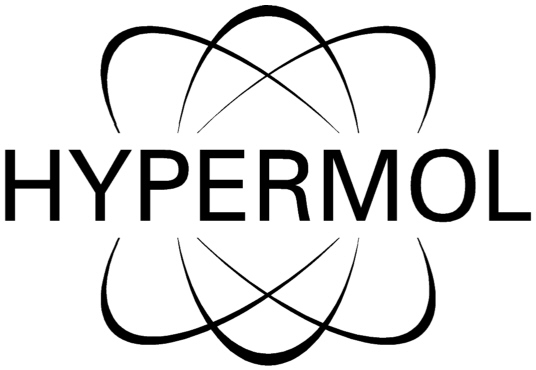Pyrene Actin
Fast and Reliable Analyses of Actin Dynamics
Pyrene-actin conjugates are reliable tools for investigating actin dynamics.
 Pyrene actin is chemically modified G-actin by covalent conjugation of a fluorescent pyrenyl group to Cys374 at the C-term of the actin molecule.
Pyrene actin is chemically modified G-actin by covalent conjugation of a fluorescent pyrenyl group to Cys374 at the C-term of the actin molecule.
Actin dynamics like polymerization, depolymerization, nucleation etc. are routinely measured by fluorometry using pyrene actin.
Hypermol guarantees a dye/protein molar ratio of 1:1 (pyrene:actin) for pyrene actin (100%) and a dye/protein molar ratio of 1:10 for pyrene actin (10%). Pyrene actin is highly polymerizable and instantly soluble.
Figure1 : Fluorometrical Analysis of Polymerization kinetics of skeletal muscle actin (red) vs. smooth muscle actin (black) and Depolymerization of skeletal muscle actin (yellow) vs. smooth muscle actin (green).
 Pyrene actin is chemically modified G-actin by covalent conjugation of a fluorescent pyrenyl group to Cys374 at the C-term of the actin molecule.
Pyrene actin is chemically modified G-actin by covalent conjugation of a fluorescent pyrenyl group to Cys374 at the C-term of the actin molecule.Actin dynamics like polymerization, depolymerization, nucleation etc. are routinely measured by fluorometry using pyrene actin.
Hypermol guarantees a dye/protein molar ratio of 1:1 (pyrene:actin) for pyrene actin (100%) and a dye/protein molar ratio of 1:10 for pyrene actin (10%). Pyrene actin is highly polymerizable and instantly soluble.
Figure1 : Fluorometrical Analysis of Polymerization kinetics of skeletal muscle actin (red) vs. smooth muscle actin (black) and Depolymerization of skeletal muscle actin (yellow) vs. smooth muscle actin (green).
Introduction
G-actin (globular actin) is a monomeric protein, which is the subunit of the actin microfilaments. Since G-actin polymerizes reversibly into double-helical microfilaments (the "actin helix"), it constitutes the "actin-based cytoskeleton" of practically all eucaryotic cells. Actin became a key player for cellular movement and force exercise (muscle, cell division). This arose only by the ability of hundreds of proteins with highly indidviual capabilities to evolve binding sites for actin and thus to utilize the actin filaments to assemble, and disassemble multi-protein-complex suprastructures needed for the motile and scaffolding functions of living cells.
To characterize actin-binding proteins, but also drugs / natural compounds / non-protein ligands in their abilty to modify the polymerization or depolymerization of actin, the actin kinetics are measured by fluorometry. This method requires Pyrene-Actin, which is chemically modified G-actin, carrying a pyrenyl group covalently bound to Cys374 at the C-term of the molecule.
The actin polymerization can be induced simply by mono- or divalent cations (in-vitro conditions). and the actin kinetic can then be measured fluorometrically. Upon excitation a characteristic kinetic is observed, which instantly shows the effect of ligands on the assembly or disassembly of the actin filaments.
Applications
Fluorometry / Fluorimetry, Pyrene Assays
1 to 4 (from a total of 4)
Introduction to Fluorometry is Actin
Pyrene Actin to measure actin polymerisation and depolymerisation
G-actin (globular actin) is a monomeric protein, which is the subunit of the actin microfilaments. Since G-actin polymerizes reversibly into double-helical microfilaments (the "actin helix"), it constitutes the "actin-based cytoskeleton" of practically all eucaryotic cells. Actin became a key player for cellular movement and force exercise (muscle, cell division). This arose only by the ability of hundreds of proteins with highly indidviual capabilities to evolve binding sites for actin and thus to utilize the actin filaments to assemble, and disassemble multi-protein-complex suprastructures needed for the motile and scaffolding functions of living cells.
To characterize actin-binding proteins, but also drugs / natural compounds / non-protein ligands in their abilty to modify the polymerization or depolymerization of actin, the actin kinetics are measured by fluorometry. This method requires Pyrene-Actin, which is chemically modified G-actin, carrying a pyrenyl group covalently bound to Cys374 at the C-term of the molecule.
The actin polymerization can be induced simply by mono- or divalent cations (in-vitro conditions). and the actin kinetic can then be measured fluorometrically. Upon excitation a characteristic kinetic is observed, which instantly shows the effect of ligands on the assembly or disassembly of the actin filaments.
Pyrene Actin to measure actin polymerisation and depolymerisation
G-actin (globular actin) is a monomeric protein, which is the subunit of the actin microfilaments. Since G-actin polymerizes reversibly into double-helical microfilaments (the "actin helix"), it constitutes the "actin-based cytoskeleton" of practically all eucaryotic cells. Actin became a key player for cellular movement and force exercise (muscle, cell division). This arose only by the ability of hundreds of proteins with highly indidviual capabilities to evolve binding sites for actin and thus to utilize the actin filaments to assemble, and disassemble multi-protein-complex suprastructures needed for the motile and scaffolding functions of living cells.
To characterize actin-binding proteins, but also drugs / natural compounds / non-protein ligands in their abilty to modify the polymerization or depolymerization of actin, the actin kinetics are measured by fluorometry. This method requires Pyrene-Actin, which is chemically modified G-actin, carrying a pyrenyl group covalently bound to Cys374 at the C-term of the molecule.
The actin polymerization can be induced simply by mono- or divalent cations (in-vitro conditions). and the actin kinetic can then be measured fluorometrically. Upon excitation a characteristic kinetic is observed, which instantly shows the effect of ligands on the assembly or disassembly of the actin filaments.








